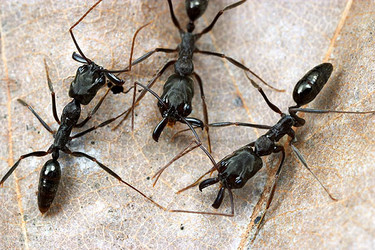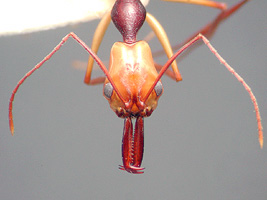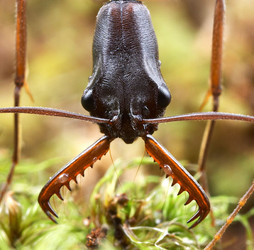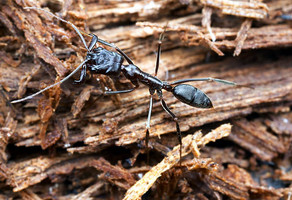Trapjaw Ants
Ants are spectacularly diverse. We currently know of about 12,000 ant species worldwide, and this is likely to be only half of the true number of ant species in the world. Each of these thousands of ant species is unique in how it looks, where it lives, and what it does. Some ants eat seeds, others farm fungus on fragments of leaves, and some feed on sugary secretions from aphids and other insects. A large percentage of ants are predators, and these typically eat other insects. Predatory ants have evolved an amazing diversity of behaviors and strategies for catching their prey. Some hunt in large swarms and overpower their prey by sheer force of numbers (these include the army ants), a few are visual predators and use their excellent eyesight to locate and stalk prey, and many use powerful venoms to paralyze and subdue otherwise agile or dangerous prey.
Perhaps the most fascinating adaptations for hunting are found in the trapjaw ants, which use extremely powerful and fast mandibular strikes to stun or skewer their prey. This behavior has been evolved independently by several different ant lineages. This podcast focuses on two related groups of trapjaw ants, the ponerine genera Odontomachus and Anochetus.


Odontomachus bauri, showing the mandibles at different stages of opening. © 2005 Alex Wild
Ponerine Trapjaw Ants: Odontomachus and Anochetus

Anochetus emarginatus. © 2004 Chris A. Schmidt
Odontomachus and Anochetus are the largest and most conspicuous of the trapjaw ants, and are also the best-studied. They are members of the subfamily Ponerinae and are sister genera, meaning that they are more closely-related to one another than they are to any other group of ants. They almost certainly evolved from a common ancestor which also hunted using trapjaws. Together these genera contain about 150 species worldwide, mainly in tropical rainforest habitats.
Like other trapjaw ants, Odontomachus and Anochetus have mandibles which can be opened up to a large angle (180° in this case; some other trapjaw ants can open their mandibles even further). The mandibles are attached to the middle of the front of the head (rather than at the sides, like in most other ants). From between the mandibles extend a pair of sensitive trigger hairs. When these hairs are brushed against potential prey, a rapid neurological response results in a near-instant closure of the mandibles, which move with extreme speed and force. In fact, this jaw closure has been measured to be the fastest movement by any animal yet measured.
The force of the mandibles on the prey either stuns or crushes it (in the case of Odontomachus) or skewers it on the sharp teeth (Anochetus). This is often followed by rapid application of the poisonous sting, which paralyzes the prey. In this way, these ants are able to catch prey that otherwise could quickly escape or prey which could use chemical or other defenses against the ant if given the opportunity. Trapjaw ants are thus very successful predators, which is demonstrated by their abundance and diversity worldwide. Odontomachus also use the force of their mandible closures for purposes besides hunting. They can actually propel themselves significant distances vertically or horizontally to escape predators or defend their nests. Similarly, they can expel small predators away from the nest.
Other Trapjaw Ants
Trapjaws have evolved at least two other times in ants. The Asian formicine genus Myrmoteras hunts using trapjaw mandibles, as do a number of myrmicine genera currently placed in the tribe Dacetini. There is some indication from recent molecular work that the Dacetini is not monophyletic, meaning that trapjaw mandibles could have evolved more than once in the Myrmicinae. In any case, myrmicine trapjaw ants show a greater diversity in the morphology and use of their trapjaws than do Myrmoteras, Odontomachus or Anochetus. Some of them have long mandibles and employ a hunting strategy that is basically similar to the ponerine trapjaw ants, while others have very short mandibles and hunt using extreme stealth, moving extraordinarily slowly while approaching prey and then snapping their mandibles shut. Some dacetines even smear soil or detritus on their bodies to camouflage themselves visually or chemically!


Strumigenys szalayi, another dacetine ant. © 2004 Alex Wild
About the Author
Chris Schmidt is a doctoral student at the University of Arizona, working in the Interdisciplinary Program in Insect Science. His research and interests span the fields of entomology and evolutionary biology. In his dissertation research he is studying the evolutionary history of ants in the subfamily Ponerinae (ponerines). These predominantly tropical ants form an ideal group in which to study social evolution in ants. Because they exhibit several traits considered ancestral within ants, ponerines offer a glimpse into what early ants may have been like. At the same time, ponerines display a wide range of derived social systems and extensive morphological and ecological diversity, making them an excellent system for studying the forces that drive social evolution.
Unfortunately, ant researchers know very little about the evolutionary history of ponerine ants and their relationships to one another. This has prevented attempts at using them to understand ant social evolution. Chris is using DNA sequence data, morphological data and fossils to reconstruct ponerine phylogeny, estimate the timing of different events in ponerine evolution, infer how ponerines attained their current worldwide distribution, and improve the higher taxonomy of the group so that it reflects evolutionary relationships (which is currently not the case).
In addition, he is studying the ponerine genera Anochetus and Odontomachus in collaboration with Neil Tsutsui (UC Irvine), and Andy Suarez (University of Illinois) and others. These ants are known as trapjaw ants because they hunt prey using powerful strikes from their mandibles, which they open to 180° and shut with extreme speed and force (in fact, this is the fastest recorded movement of any animal). Chris is inferring a detailed phylogeny of these genera using molecular data, providing a framework for studying their remarkable behavior and morphology.




 This page is part of the project "New Strategies for Life Sciences Outreach in
Arizona: Developing a Digital Library of Audio and Video Features in the
Context of the Tree of Life Web Project" funded by the “Anyplace
Access for Arizonans” Initiative under the
This page is part of the project "New Strategies for Life Sciences Outreach in
Arizona: Developing a Digital Library of Audio and Video Features in the
Context of the Tree of Life Web Project" funded by the “Anyplace
Access for Arizonans” Initiative under the 



 Go to quick links
Go to quick search
Go to navigation for this section of the ToL site
Go to detailed links for the ToL site
Go to quick links
Go to quick search
Go to navigation for this section of the ToL site
Go to detailed links for the ToL site